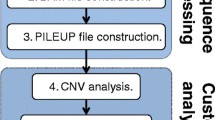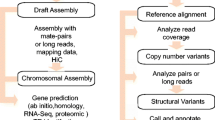Abstract
Whole genome sequencing of human fungal pathogens has revolutionized the speed and accuracy in which sequence variants that cause antifungal resistance can be identified. Genome rearrangements resulting in copy number variation (CNV) are a significant source of acquired antifungal drug resistance across diverse fungal species. Some CNVs are transient in nature, while other CNVs are stable and well tolerated even in the absence of antifungal drugs. By visualizing whole genome sequencing read depth as a function of genomic location, CNVs and CNV breakpoints (genomic positions where the copy number changes occur relative to the rest of the genome) are rapidly identified. A similar analysis can be used to visualize allele ratio changes that occur across the genomes of heterozygous fungal species, both in the presence and absence of CNVs. This protocol walks through the bioinformatic analysis of CNVs and allele ratios utilizing free, open-source visualization tools. We provide code to use with an example dataset (matched antifungal drug-sensitive and drug-resistant Candida albicans isolates) and notes on how to expand this protocol to other fungal genomes.
Access this chapter
Tax calculation will be finalised at checkout
Purchases are for personal use only
Similar content being viewed by others
References
Janbon G, Sherman F, Rustchenko E (1998) Monosomy of a specific chromosome determines L-sorbose utilization: a novel regulatory mechanism in Candida albicans. Proc Natl Acad Sci U A 95:5150–5155
Dunham MJ, Badrane H, Ferea T et al (2002) Characteristic genome rearrangements in experimental evolution of Saccharomyces cerevisiae. Proc Natl Acad Sci U A 99:16144–16149
Selmecki A, Forche A, Berman J (2006) Aneuploidy and isochromosome formation in drug-resistant Candida albicans. Science 313:367–370
Ford CB, Funt JM, Abbey D et al (2015) The evolution of drug resistance in clinical isolates of Candida albicans. elife 4:e00662
Yang F, Todd RT, Selmecki A et al (2021) The fitness costs and benefits of trisomy of each Candida albicans chromosome. Genetics 218
Marichal P, Vanden Bossche H, Odds FC et al (1997) Molecular biological characterization of an azole-resistant Candida glabrata isolate. Antimicrob Agents Chemother 41:2229–2237
Fundyga RE, Kuykendall RJ, Lee-Yang W et al (2004) Evidence for aneuploidy and recombination in the human commensal yeast Candida parapsilosis. Infect Genet Evol J Mol Epidemiol Evol Genet Infect Dis 4:37–43
Demers EG, Biermann AR, Masonjones S et al (2018) Evolution of drug resistance in an antifungal-naive chronic Candida lusitaniae infection. Proc Natl Acad Sci U S A 115:12040–12045
Bing J, Hu T, Zheng Q et al (2020) Experimental evolution identifies adaptive aneuploidy as a mechanism of fluconazole resistance in Candida auris. Antimicrob Agents Chemother 65
Sionov E, Lee H, Chang YC et al (2010) Cryptococcus neoformans overcomes stress of azole drugs by formation of disomy in specific multiple chromosomes. PLoS Pathog 6:e1000848
Hu G, Wang J, Choi J et al (2011) Variation in chromosome copy number influences the virulence of Cryptococcus neoformans and occurs in isolates from AIDS patients. BMC Genomics 12:526
Todd RT, Wikoff TD, Forche A et al (2019) Genome plasticity in Candida albicans is driven by long repeat sequences. elife 8
Selmecki A, Gerami-Nejad M, Paulson C et al (2008) An isochromosome confers drug resistance in vivo by amplification of two genes, ERG11 and TAC1. Mol Microbiol 68:624–641
Todd RT, Selmecki A (2020) Expandable and reversible copy number amplification drives rapid adaptation to antifungal drugs. elife 9
Gresham D, Desai MM, Tucker CM et al (2008) The repertoire and dynamics of evolutionary adaptations to controlled nutrient-limited environments in yeast. PLoS Genet 4:e1000303
Payen C, Di Rienzi SC, Ong GT et al (2014) The dynamics of diverse segmental amplifications in populations of Saccharomyces cerevisiae adapting to strong selection. G3 Bethesda 4:399–409
Adamo GM, Lotti M, Tamas MJ et al (2012) Amplification of the CUP1 gene is associated with evolution of copper tolerance in Saccharomyces cerevisiae. Microbiology 158:2325–2335
Hull RM, Cruz C, Jack CV et al (2017) Environmental change drives accelerated adaptation through stimulated copy number variation. PLoS Biol 15:e2001333
Lauer S, Avecilla G, Spealman P et al (2018) Single-cell copy number variant detection reveals the dynamics and diversity of adaptation. PLoS Biol 16:e3000069
Harrison BD, Hashemi J, Bibi M et al (2014) A tetraploid intermediate precedes aneuploid formation in yeasts exposed to fluconazole. PLoS Biol 12:e1001815
Chang FM, Ou TY, Cheng WN et al (2014) Short-term exposure to fluconazole induces chromosome loss in Candida albicans: an approach to produce haploid cells. Fungal Genet Biol 70:68–76
Hickman MA, Paulson C, Dudley A et al (2015) Parasexual ploidy reduction drives population heterogeneity through random and transient aneuploidy in Candida albicans. Genetics 200:781–794
Gerstein AC, Fu MS, Mukaremera L et al (2015) Polyploid titan cells produce haploid and aneuploid progeny to promote stress adaptation. MBio 6:e01340–e01315
Okagaki LH, Strain AK, Nielsen JN et al (2010) Cryptococcal cell morphology affects host cell interactions and pathogenicity. PLoS Pathog 6:e1000953
Zaragoza O, Garcia-Rodas R, Nosanchuk JD et al (2010) Fungal cell gigantism during mammalian infection. PLoS Pathog 6:e1000945
Zhu YO, Sherlock G, Petrov DA (2016) Whole genome analysis of 132 clinical Saccharomyces cerevisiae strains reveals extensive ploidy variation. G3 Bethesda 6:2421–2434
Todd RT, Braverman AL, Selmecki A (2018) Flow cytometry analysis of fungal ploidy. Curr Protoc Microbiol 50:e58
Marr KA, White TC, van Burik JA et al (1997) Development of fluconazole resistance in Candida albicans causing disseminated infection in a patient undergoing marrow transplantation. Clin Infect Dis Off Publ Infect Dis Soc Am 25:908–910
Marr KA, Lyons CN, Rustad TR et al (1998) Rapid, transient fluconazole resistance in Candida albicans is associated with increased mRNA levels of CDR. Antimicrob Agents Chemother 42:2584–2589
Marr KA, Lyons CN, Ha K et al (2001) Inducible azole resistance associated with a heterogeneous phenotype in Candida albicans. Antimicrob Agents Chemother 45:52
Selmecki AM, Dulmage K, Cowen LE et al (2009) Acquisition of aneuploidy provides increased fitness during the evolution of antifungal drug resistance. PLoS Genet 5:e1000705
Abbey DA, Funt J, Lurie-Weinberger MN et al (2014) YMAP: a pipeline for visualization of copy number variation and loss of heterozygosity in eukaryotic pathogens. Genome Med 6:100
Li H, Durbin R (2009) Fast and accurate short read alignment with burrows-wheeler transform. Bioinformatics 25:1754–1760
Li H, Handsaker B, Wysoker A et al (2009) The sequence alignment/map format and SAMtools. Bioinformatics 25:2078–2079
Bolger AM, Lohse M, Usadel B (2014) Trimmomatic: a flexible trimmer for Illumina sequence data. Bioinformatics 30:2114–2120
Van der Auwera GA, Carneiro MO, Hartl C et al (2013) From FastQ data to high confidence variant calls: the genome analysis toolkit best practices pipeline. Curr Protoc Bioinforma 43:11.10.1-11.10.33
Poplin R, Ruano-Rubio V, DePristo MA, et al (2018) Scaling accurate genetic variant discovery to tens of thousands of samples. bioRxiv 201178
Danecek P, Auton A, Abecasis G et al (2011) The variant call format and VCFtools. Bioinforma Oxf Engl 27:2156–2158
García-Alcalde F, Okonechnikov K, Carbonell J et al (2012) Qualimap: evaluating next-generation sequencing alignment data. Bioinforma Oxf Engl 28:2678–2679
Acknowledgements
We are grateful to Petra Vande Zande, Natthapon Soisangwan, and Taylor Crooks for providing helpful feedback on the manuscript and to Robin Dowell and her team for providing free and accessible short-read sequence alignment workshops. Funding was provided by the National Institute of Health (R01AI143689) and the Burroughs Wellcome Fund Investigators in the Pathogenesis of Infectious Diseases (no. 1020388) to A.S.
Author information
Authors and Affiliations
Corresponding author
Editor information
Editors and Affiliations
Rights and permissions
Copyright information
© 2023 The Author(s), under exclusive license to Springer Science+Business Media, LLC, part of Springer Nature
About this protocol
Cite this protocol
Todd, R.T., Selmecki, A. (2023). Copy Number Variation and Allele Ratio Analysis in Candida albicans Using Whole Genome Sequencing Data. In: Krysan, D.J., Moye-Rowley, W.S. (eds) Antifungal Drug Resistance. Methods in Molecular Biology, vol 2658. Humana, New York, NY. https://doi.org/10.1007/978-1-0716-3155-3_8
Download citation
DOI: https://doi.org/10.1007/978-1-0716-3155-3_8
Published:
Publisher Name: Humana, New York, NY
Print ISBN: 978-1-0716-3154-6
Online ISBN: 978-1-0716-3155-3
eBook Packages: Springer Protocols




